Sailing Avocet: A New Adventure Begins
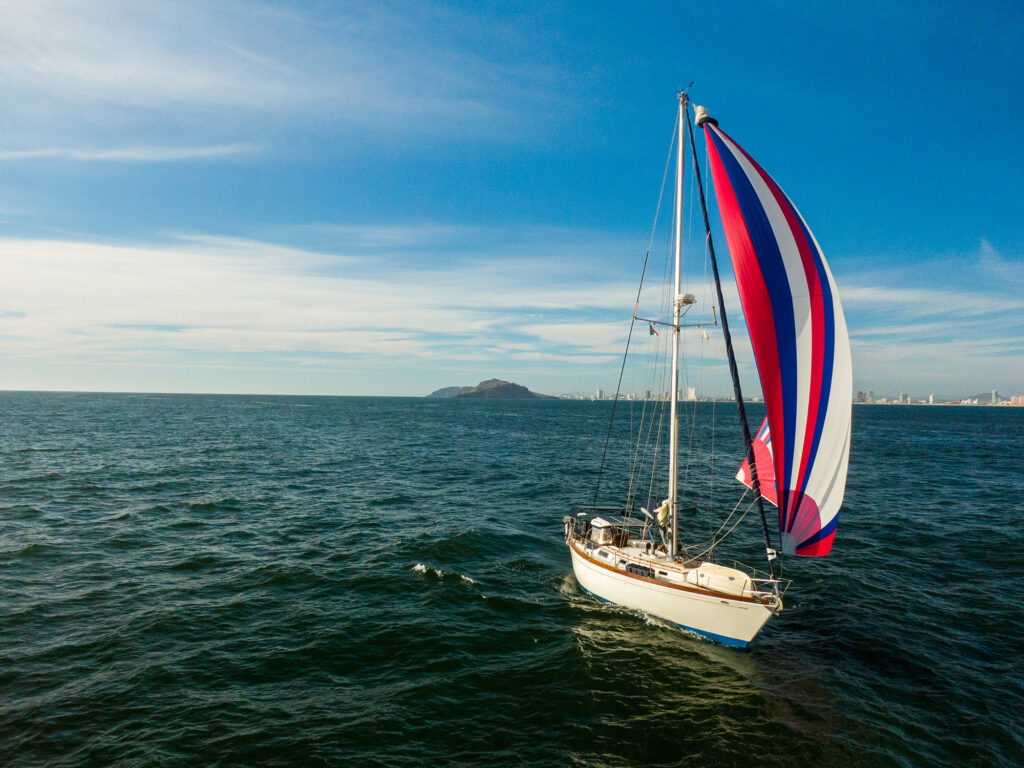 We stuck around Mazatlán a bit longer than planned since there was SO much to explore in the beautiful sea-side city, but Banderas Bay was calling us back, so we raised our sails and pointed south to reunite with our friends.
Courtesy Marissa Neely
We stuck around Mazatlán a bit longer than planned since there was SO much to explore in the beautiful sea-side city, but Banderas Bay was calling us back, so we raised our sails and pointed south to reunite with our friends.
Courtesy Marissa Neely
EDITOR’S NOTE: Every boat has a story. So does every boat owner. And few tell those stories better than Marissa and Chris, the crew of Avocet, a 1979 41-foot Cheoy Lee. They met the boat in February 2018, just three months before college graduation, got married in June 2018, and have been liveaboards ever since. Avocet’s journey has only just begun, and as Cruising World’s newest ambassadors, the Avocet crew share their adventures with our community, from the technical aspects of cruising a classic sailboat to the breathtaking destinations they visit to the challenges (and triumphs!) that come with the liveaboard life.
Ahoy, from AvocetMy name is Marissa, and I am half of the crew on Avocet, a 1979 41-foot Cheoy Lee that my partner, Chris, and I have been living aboard since 2018.
Chris grew up in a sailing family, spending time on small lake boats and sailing near the San Francisco Bay area aboard his family’s Mason 43. His older brother purchased a Hans Christian 33, Prism, to cruise the world, paving the way for us to follow in his wake half a decade later.
Chris got me involved in the sport early in our relationship. We were barely 15 when he persuaded me to crew for him in the annual High Sierra Regatta, where I caught the sailing bug. After high school, Chris asked me to marry him in Costa Rica while we were aboard his brother’s boat. Of course, I said yes to a life of adventure, which led us to where we are now.
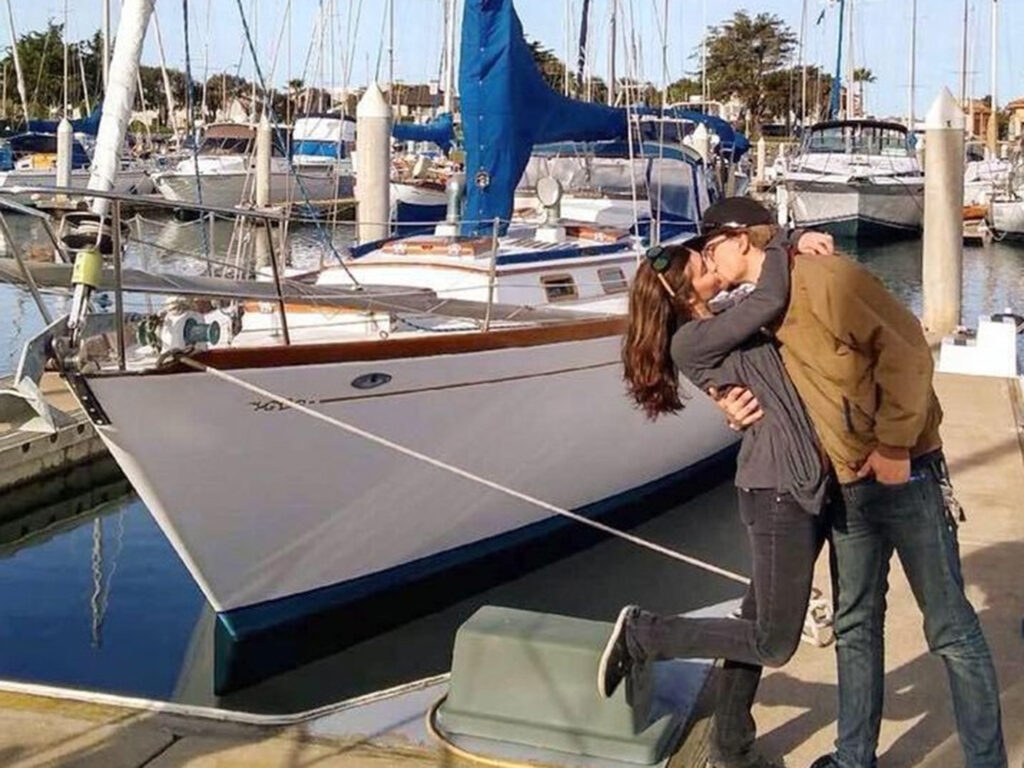 This photo was from the first day we became the new crew aboard Avocet.
Courtesy Marissa Neely
This photo was from the first day we became the new crew aboard Avocet.
Courtesy Marissa Neely
Our current story starts with how we found our beloved Avocet. We met the boat in February 2018, just three months before college graduation. We signed the papers in March, and Chris spent nearly every weekend driving eight hours to prepare Avocet for our move-in day.
Then, in May, we began our adult lives—him with his bachelor’s degree in social sciences, and me with bachelors’ in ski business, resort management and global business management. We got married on June 2, 2018, just two days before Chris carried me from the dock to Avocet’s cockpit and we unpacked on board.
The DiscoveryBack when Chris and I were looking for boats in 2018, Avocet was not even on our radar. We were looking for something simpler, like a Catalina 36. At the time, we had no intentions of cruising, and we were looking for a crash pad while Chris finished his studies at film school in San Francisco Bay.
We convinced ourselves that the Catalina 36 was everything we wanted, until we stepped aboard one in Southern California and realized it wouldn’t suit our lifestyle needs. We had no Plan B, but we did have Chris’ brother Jon with us. He found Avocet.
“We cruised with a boat like this in Mexico,” Jon said as he boarded the boat. After a few moments on board, Chris felt at home, comparing the warm teak walls to his family’s Mason 43. I was not as easily charmed—I thought the interior was atrocious—but Chris begged me to give it a minute.
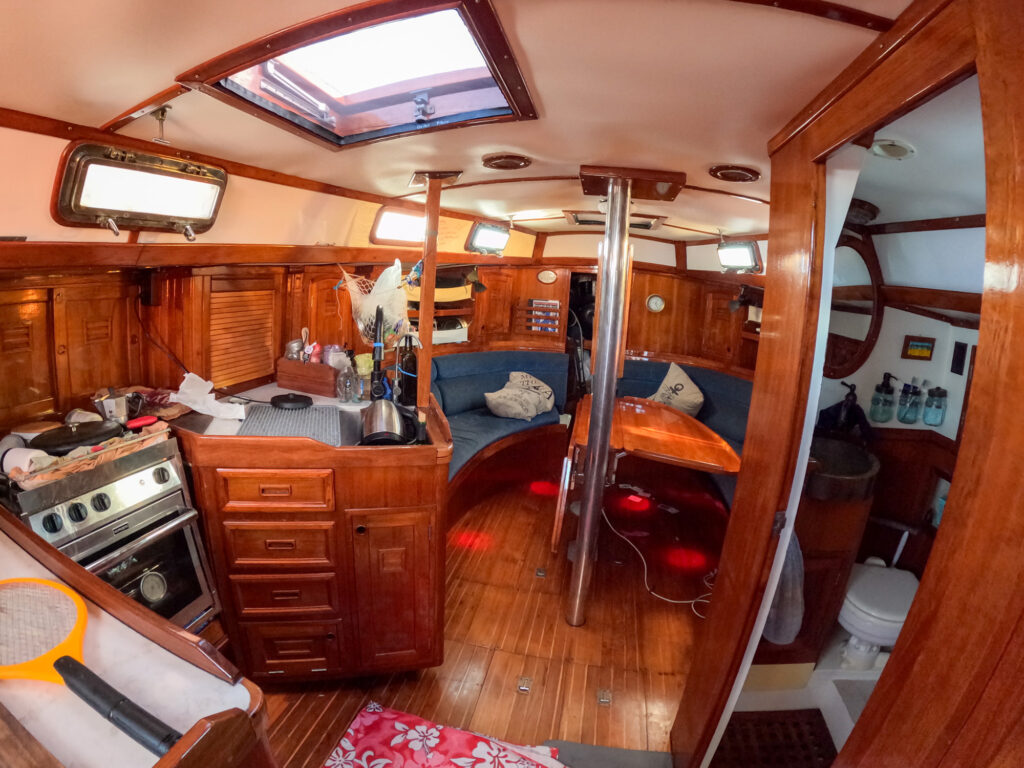 Avocet underway. Notice the fly swatter, bug screens and natural tilt!
Courtesy Marissa Neely
Avocet underway. Notice the fly swatter, bug screens and natural tilt!
Courtesy Marissa Neely
After we drove away, Chris couldn’t stop thinking about the boat. His offer to the seller was laughable at best, probably around $25,000, which is what we had saved. The seller rejected that offer, so Chris wrote a letter to the seller, explaining who we were and why we would be honored to buy it. We settled around $30,000, which was $10,000 less than the original listed price. We still had to get a bank loan, but Avocet was ours.
The ConfusionPeople recognize that Avocet is a Cheoy Lee but often fail to identify the model. On the outside, the boat looks strikingly similar to the Offshore 41 and Pedrick 41, but has key differences. Cheoy Lee had seen a similar design from naval architect Ray Richards, the designer of the Offshore, and subsequently designed its own Cheoy Lee 41. Richards’ new-at-the-time element was a 6-foot-deep cruising fin, in which the forefoot is a cutaway and the rudder is attached to a skeg. Richards described the boat as “stiff as a church,” which we have found to be very true.
Unlike Avocet, the Offshore 41s don’t share the same tumblehome, leaving them much narrower with a different sheer. Inside, Avocet’s saloon is oval-shaped, unlike the semi-circle cut of the Offshore. Our boat’s head is abaft the saloon on the starboard side, forward of the stateroom, with a closet separating them. In the Offshore, there is no closet.
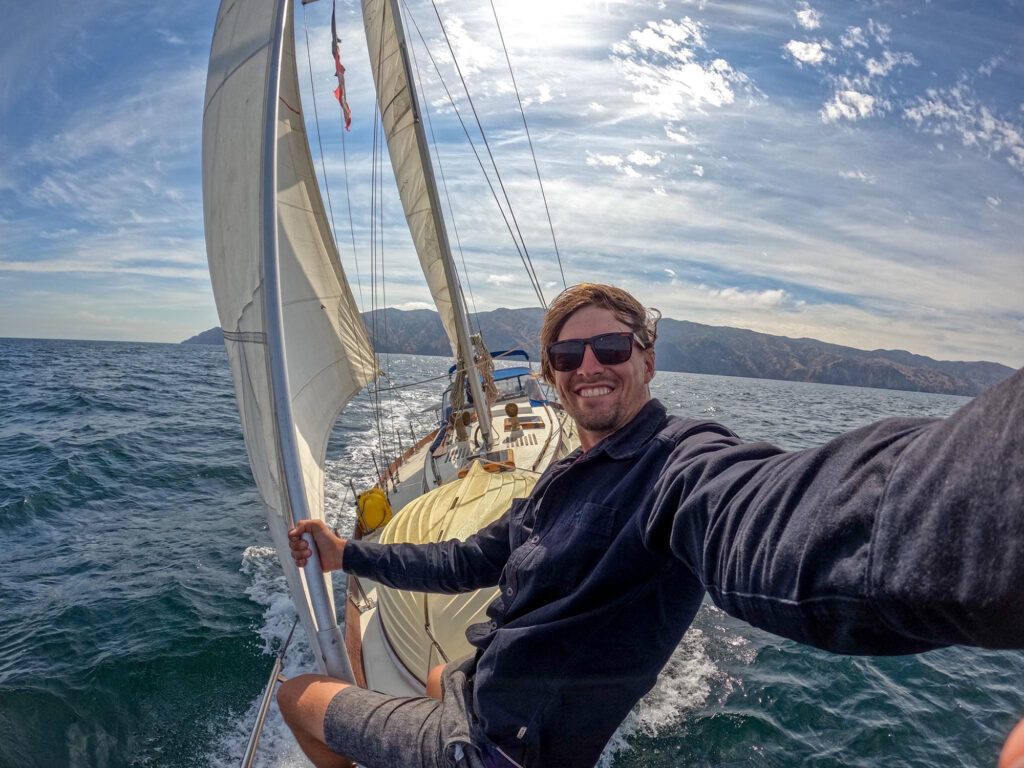 Sailing from Catalina back to Ventura, California. Avocet looked a bit different back in 2021, before the hardtop dodger build, the solar Bimini installation, and right before we got sweet, new sails.
Courtesy Marissa Neely
Sailing from Catalina back to Ventura, California. Avocet looked a bit different back in 2021, before the hardtop dodger build, the solar Bimini installation, and right before we got sweet, new sails.
Courtesy Marissa Neely
Avocet is also different from the Offshore below the waterline, thanks to Avocet’s modified fin keel and separated skeg-hung rudder. Our boat’s prop shaft comes right out of the keel, making our shaft 4½ feet long. Another notable difference is that the Offshore has a slightly taller cabin top.
Unfortunately, there is not much existing literature on Cheoy Lee 41s—especially sloops—since they seemed to have been built to order and highly customized by whoever commissioned them. We asked Cheoy Lee for help in our hunt to find details about Avocet, but no records were in their database.
Richards did kindly answer my emails and provided some insight, supporting our own findings: “I am not particularly familiar with it, but your email jogged my memory that indeed, Cheoy Lee had Pedrick design a 41, ‘borrowing’ from mine but with the, by then, contemporary style of underbody and flatter sheer. I also recall that Pedrick was or had been in the Sparkman & Stephens office, a factor that Cheoy Lee probably and understandably would have figured as good for sales. There were more than a few misquotes and errors. For example, I turned out four, not 10 designs for Cheoy Lee. The first was a 39, a larger and heavier version of an aluminum one-tonner that had received some good press, but it was totally away from the type and style of CL’s market niche. It was flush-decked and had a plumb transom from which a dirty big outboard rudder was hung. Tad Woodhull, Lyon Yachts, Essex, Connecticut, had one and did well racing it in Long Island Sound. It was he who stimulated Cheoy Lee toward replacing Phil Rhodes’ very handsome Reliant, which came to be sold as their Offshore 40. Thus came my 41, which was originally designated Offshore 40. Maybe that, in CL’s mind, was much like replacing a Richards with a Pedrick. The 32 came next. It was followed by the 38, very similar in features to the 41.”
There only seem to be eight CL41s in existence, reflected on the Cheoy Lee Association owners page, and Avocet appears to be one of the only sloops.
The ConstructionLike most boats of this vintage, Avocet has a solid fiberglass hull. According to the company literature, the thickness in these boats ranges from about seven-sixteenths of an inch at the sheer to 1 inch, but we have found Avocet to be five-eighths of an inch at the sheer and as much as 2 inches at the keel.
This level of fiberglass production was uncommon at the time and gave Cheoy Lee a good reputation for building robust boats. Unlike many other early fiberglass classics, the Cheoy Lee 41s had fiberglass decks, most with a teak overlay. The previous owner removed Avocet’s teak deck, most likely in Mexico in 2004. Beneath the fiberglass deck is mahogany planking that serves as core. We inspected it. Dry as a bone.
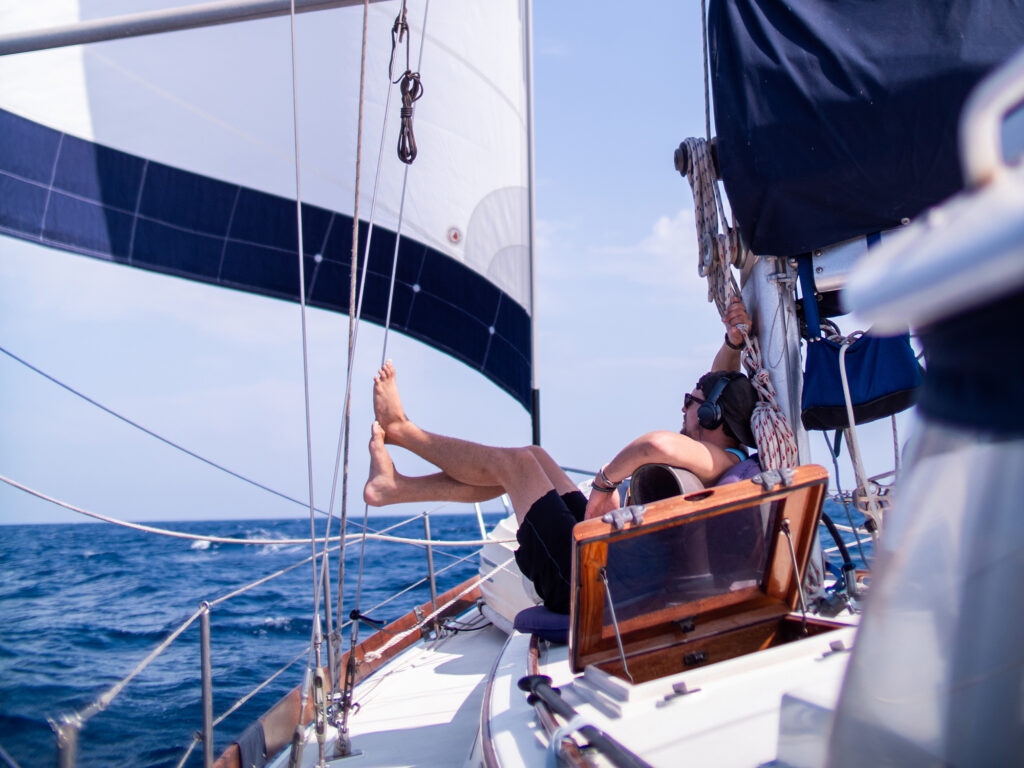 It was a 35-hour sail to Guaymas from Topolobampo. We planned our departure accordingly so we would arrive in Guaymas at daybreak, but we were a tad too generous with the timing—we forgot how fast Avocet is.
Courtesy Marissa Neely
It was a 35-hour sail to Guaymas from Topolobampo. We planned our departure accordingly so we would arrive in Guaymas at daybreak, but we were a tad too generous with the timing—we forgot how fast Avocet is.
Courtesy Marissa Neely
Cheoy Lee poured its own cast iron ballasts, but our keel is lead, which is denser, softer and not subject to corrosion. Cheoy Lee Shipyards said it was unlikely that the boat originally had a lead keel, but it’s possible that Avocet’s original owner commissioned it with lead ballast, for which we are thankful.
On the other hand, Avocet was built with poor-quality stainless steel. The chainplates crumbled in our hands. Fasteners were a problem, too. Most owners, like us, have replaced the shoddy metal, sometimes paving the way for other problems, such as leaks. We had this issue when the fasteners in our toe rail corroded, leaving voids that allowed water intrusion into our interior. Instead of replacing the toe rail, we removed it and added a bulwark. This let us glass over the deck-to-hull joint, reinforcing the structural integrity of our boat. It is, so far, the crowning upgrade on our extensive project list.
Avocet’s previous owner also replaced the Sitka spruce spar in 2004 with our aluminum mast, which we refitted in 2021. Avocet is deck-stepped with a single spreader and a relatively short boom, meaning the boat is heavily headsail-driven.
I know what you are thinking: A cruising boat with a deck-stepped mast? How could this be? Well, as with many things in sailing, there is a deck-stepped versus keel-stepped debate.
Deck-stepped boats have masts that are more flexible, making the mast easier to adjust for optimum performance by making small adjustments to the standing rigging. Going upwind, the backstay, runners and check stays can have tension added to tighten the stays and pull the mast aft. This will both rake the mast aft, giving it weather helm, and tension the headstay for added pointing ability.
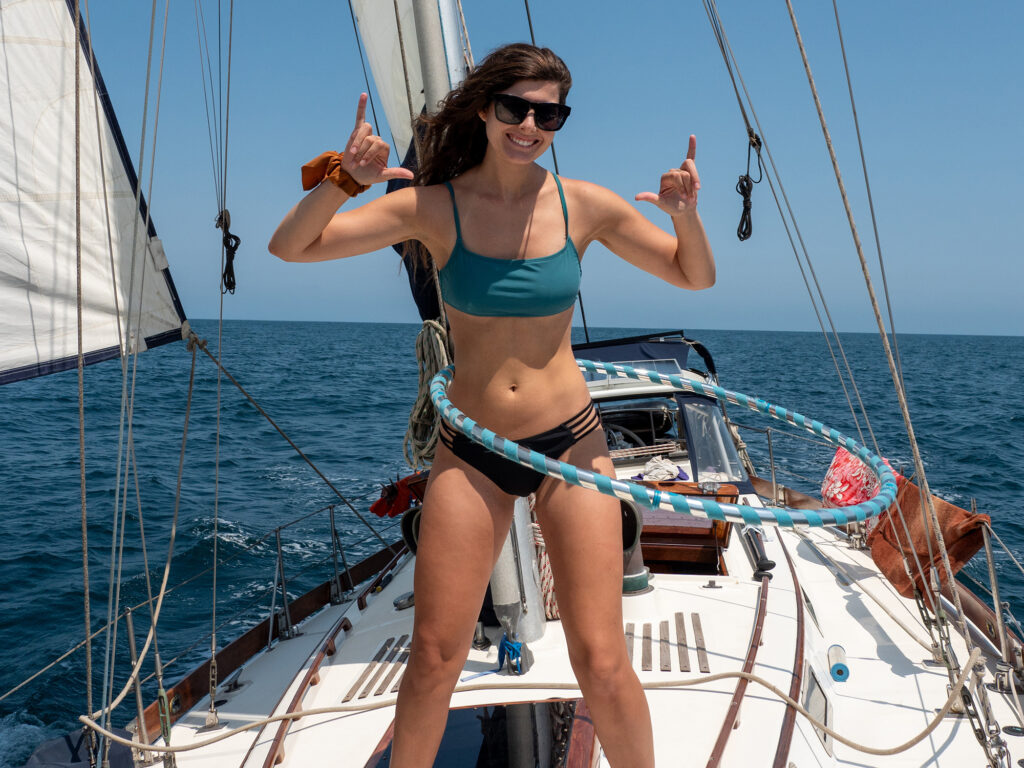 Our first day underway was calm, and I couldn’t resist testing my balance on the bow by doing a bit of hooping.
Courtesy Marissa Neely
Our first day underway was calm, and I couldn’t resist testing my balance on the bow by doing a bit of hooping.
Courtesy Marissa Neely
If all the stays fail on the mast, it will fall over, since it stands on the deck totally reliant on the rigging—one of the many reasons we replaced our chainplates and all the rigging, and beefed up our mast step in 2021.
Avocet’s geared steering quadrant is also unusual. Unlike with cable or worm steering, the input from the helm goes directly to a pinion gear, which turns a larger planetary gear, then a drive shaft mounted vertically inside the binnacle. This connects directly to the rudder shaft through two more gears. There is little that can go wrong with this system. All the gears are locked together with large components, eliminating the risk of cable failure.
With so much mechanical advantage, Avocet has a different feel than other boats. Because of the geared steering, we can never feel weather helm, which takes some getting used to if you are a seasoned sailor. We also have an easy time hand-steering, and our autopilot has more control. The lock-to-lock at the wheel takes four complete revolutions of the helm. In the time we have owned Avocet, we have really grown to like this system.
Avocet also has an inboard Perkins 4-108 diesel engine that is midship between the galley and head. With the weight concentrated on centerline, we have less pitching. The weight is also low, with the Perkins below the cabin sole, about 2 feet below the waterline. It’s not the easiest location for maintenance, but it’s a valuable addition to our lead ballast, making it the best possible location for sailing performance.
And, our cabin sole is removable for access the engine. We also have a 6-foot-deep bilge with pumps and alarms to address any incoming water and eliminate flooding.
If our engine were above the cabin sole and beneath the companionway (like many are), it would be at equal risk of water damage due to a green wave—a good reason why we relocated our batteries to a watertight spot.
The PerformanceAlthough Avocet isn’t truly an International Offshore Rule vessel, it shares a lot of traits, having been built at the height of IOR times in the late ’70s. The hull has bow and stern overhangs, the boat has a wide beam, and it is heavily headsail-driven. It sails incredibly well for its heavy weight, too. With a modified fin keel and a large rudder far aft on the stern, Avocet always feels well-footed underway. The keel digs deep into the sea while the rudder has significant control on any given point of sail.
At 26,000 pounds, Avocet is not a light boat, but it carries the weight in all the right places. Our favorite attribute is the boat’s low-slung nature. The freeboard is relatively low off the water, and much of the weight is carried below the waterline. This all contributes to Avocet’s best sailing characteristic, which is stiffness.
In a generous breeze of 15 to 25 knots, we can carry all our canvas and keep a heel no more than 15 to 20 degrees, making life aboard blissfully comfortable. Avocet’s unassuming image is what makes it such a good boat a comfortable racer in disguise. That’s how we squeezed out a second place showing in this year’s Banderas Bay Regatta, with the heaviest handicap in the entire race.
PostscriptAvocet‘s journey has only just begun, and we’re thrilled to share our adventures with the Cruising World community. As Cruising World‘s newest ambassadors, you’ll get a front-row seat to our experiences, from the technical aspects of cruising a unique boat like Avocet to the breathtaking destinations we encounter and the challenges (and triumphs!) that come with full-time liveaboard life.
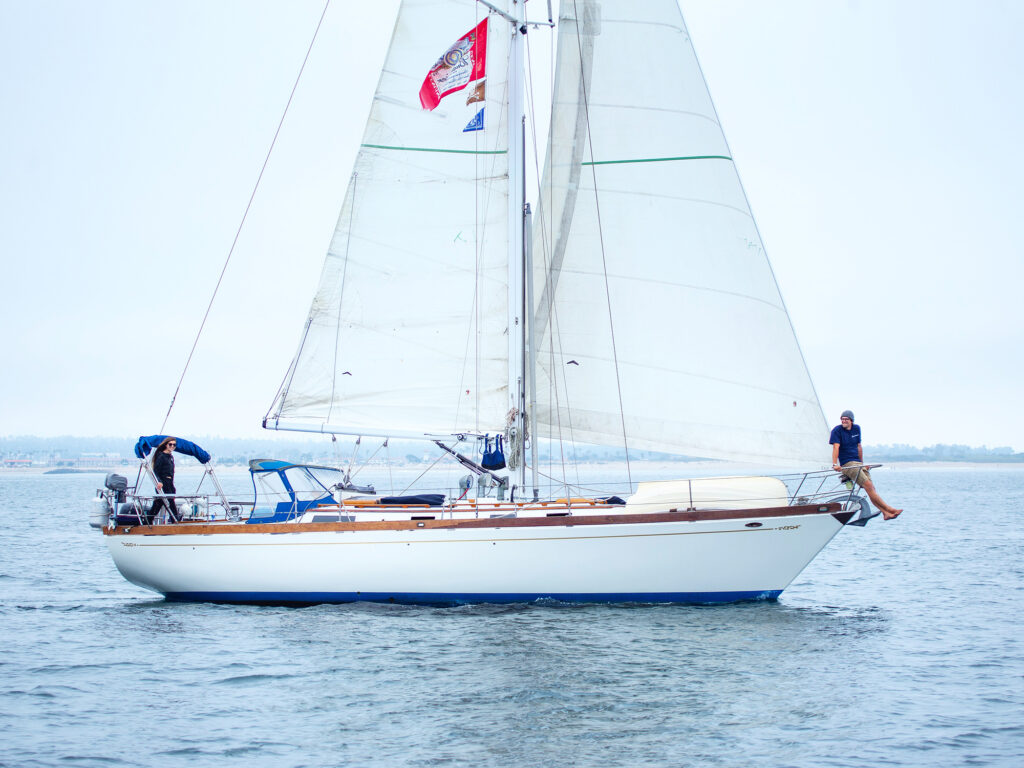 Although we are able to to find comfort in uncomfortable situations, it doesn’t mean everyone will. For us, this lifestyle is trying as it is rewarding.
Courtesy Marissa Neely
Although we are able to to find comfort in uncomfortable situations, it doesn’t mean everyone will. For us, this lifestyle is trying as it is rewarding.
Courtesy Marissa Neely
In the coming months, we’ll be chronicling our ongoing adventures, giving you a variety of specially curated content from our cruising life, from boat projects and maintenance to the realities of full-time liveaboard life, managing limited space and staying connected with loved ones back home.We believe Avocet‘s story resonates with many sailors. It’s a testament to the spirit of adventure, the joy of living a life less ordinary and the unique bond that forms between a crew and its boat. We’re excited to share this journey with you, so stay tuned for more updates from Avocet! In the meantime, learn more about what we’re up to now at svavocet.com.
The post Sailing Avocet: A New Adventure Begins appeared first on Cruising World.
- Home
- About Us
- Write For Us / Submit Content
- Advertising And Affiliates
- Feeds And Syndication
- Contact Us
- Login
- Privacy
All Rights Reserved. Copyright , Central Coast Communications, Inc.